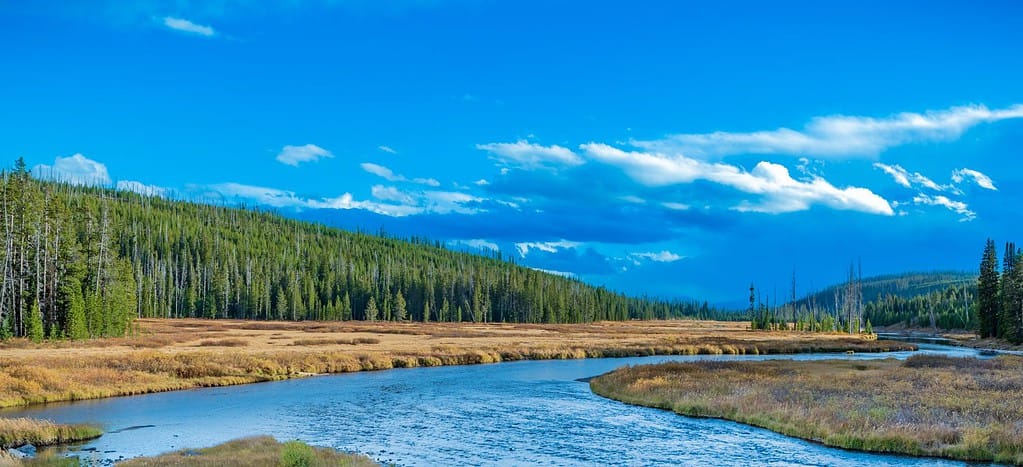The 10 States That Pay the Absolute Least Federal Tax
Have you ever wondered which state pays the absolute least federal taxes? Look no further as we offer a glimpse into the ten states that doled out the fewest tax payments in 2022. The respective economies and relevant industries in each state play a huge role in the amount of money that the IRS collects. We break down each state’s unique tax structures, their distinct economies, and the factors that reduce the burdens of federal taxes.
10. South Dakota

©Jacob Boomsma/iStock via Getty Images
Kicking off our list is the gorgeous state of South Dakota. With roughly 900,000 residents living within its borders, South Dakota is home to the sixth smallest population in the country. In 2022, the IRS collected just $13,497,584 in federal taxes from the Mount Rushmore State. South Dakota does not impose income taxes on individuals and has a large population of retirees. Its economy is centered around both agriculture and tourism, which explains the state’s reduced federal tax contribution. During the first quarter of 2023, South Dakota accounted for just 0.2% of the U.S. economy, ranking it the 49th smallest economy in the country.
9. Maine

©Sean Pavone/Shutterstock.com
In 2022, Maine contributed just $11,657,460 in federal taxes. Despite the presence of an income tax, Maine employs a very progressive system that places an emphasis on high-earning individuals. The state offers reduced tax rates for low-income individuals, providing credits and deductions to the vast majority of such households. The forestry and agricultural industries are extremely important to Maine’s economy, yet the state also heavily relies on the manufacturing industry. Products such as paper and wood are among Maine’s biggest exports. The lack of a modern economy is the biggest reason why the state contributed the ninth fewest federal taxes in 2022.
8. New Mexico

©Dean_Fikar/iStock via Getty Images
New Mexico is home to several thriving industries, yet its unique taxation system is aimed at promoting job growth and business investment. Last year, New Mexico paid just $11,655,045 to the IRS. Oil and gas production are among the top industries in the state, with government jobs ranking third. These successful industries create tax breaks for employees and low-income earners. Although New Mexico has a much higher employment rate compared to the rest of the country, the state is home to thousands of retirees. Residents of all tax brackets receive large tax breaks and credits, making it an attractive place to live regardless of income.
7. Hawaii

©segawa7/iStock via Getty Images
The stunning islands of Hawaii heavily rely on tourism to sustain its economy. In 2022, the state contributed $11,583,752 in federal taxes. Hawaii’s wildly unique tax structure is in place due to limited economic diversity and the high cost of living. A general excise tax replaces the traditional sales tax, which benefits the state’s 1.5 million residents. Outside of tourism, manufacturing, and exports make up the second-largest sector in the state. Hawaii has the 48th-ranked economy in the country and depends on a wide range of exports to stimulate its struggling fiscal system.
6. Montana

©christiannafzger/ via Getty Images
Last year, Montana paid a meager $10,677,150 to the IRS. The two largest earning industries in the state are agriculture and Native American Casinos. Throughout 2023, Montana’s casinos are on pace to generate a record $100 million in revenue. Petroleum refineries and construction companies also contribute to state revenue, yet Montana ranks among the worst economies in the country. During the first quarter of 2023, Montana accounted for just 0.2% of the U.S. economy. The 1.2 million residents living in Montana benefit from reduced income taxes and the lack of a state sales tax.
5. North Dakota

©Sanghwan Kim/iStock via Getty Images
North Dakota is one of the few states that does not impose state income tax. Only 650,000 individuals reside in the state, making it one of the smallest populations in the country. Energy production, agriculture, and manufacturing are the largest industries in North Dakota. Each industry benefits from large tax breaks, yet the federal government gives the energy sector a ton of leeway. The state’s small population and limited economic diversity make it one of the weakest economies in the United States. In 2022, North Dakota dished out just $9,008,488 in federal taxes.
4. West Virginia

©Jon Bilous/iStock via Getty Images
Once reliant on the coal mining industry, West Virginia recently transitioned toward a manufacturing and agricultural-based economy. Low-income residents benefit from the numerous tax breaks and prominent manufacturing industries within the state. The majority of West Virginia’s population is within the lowest tax bracket, meaning more tax credits and deductions for its residents. The IRS collected $8,434,626 from West Virginia in 2022. Despite ranking among the lowest earners in the United States, West Virginia is home to the 62nd-largest global economy.
3. Wyoming

©Ansel B/Shutterstock.com
Wyoming is home to the smallest state population in the United States. It is also known for having no state income tax and minimal sales tax. Due to its small population and struggling economy, Wyoming contributed only $7,954,734 in federal taxes last year. Energy production and tourism are the two largest industries in the state. Wyoming is also famous for mining natural resources such as coal, natural gas, and oil. With less than 600,000 residents, the state offers tax breaks to individuals within all tax brackets.
2. Alaska

©SteveAllenPhoto/iStock via Getty Images
Alaska is one of the most unique states in the country, as it provides annual stipends to its residents. The Permanent Fund Dividend pays $1300 to each resident who has lived within the state for a full calendar year. The funds are doled out to residents from the profits earned by the prominent oil industry. Additionally, Alaska has the second smallest population in the country and a desperately struggling economy. Oil, natural gas, and fishing are the only successful industries remaining in the state. Last year, the IRS collected $6,572,445 from Alaska.
1. Vermont

©Wirestock Creators/Shutterstock.com
The state that pays the absolute least federal taxes is none other than Vermont. Its relatively small population and progressive income tax structure explain why the state paid only $5,803,277 to the IRS in 2022. Vermont provides various tax credits aimed at reducing the burden on low-income residents. Despite having a diverse economy, Vermont ranks 41st in the country in economic performance. With an emphasis on tourism, agriculture, and fishing, the state is left without many high-earning industries. Overall, Vermont pays out the fewest federal taxes in the entire country.
| Name of State | 2022 Tax Payment |
|---|---|
| Vermont | $5,803,277 |
| Alaska | $6,572,445 |
| Wyoming | $7,954,734 |
| West Virginia | $8,434,626 |
| North Dakota | $9,008,488 |
| Montana | $10,677,150 |
| Hawaii | $11,583,752 |
| New Mexico | $11,655,045 |
| Maine | $11,657,460 |
| South Dakota | $13,497,584 |
The photo featured at the top of this post is © Wirestock Creators/Shutterstock.com









